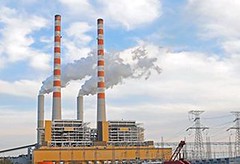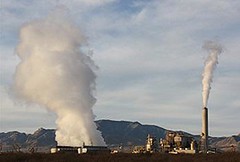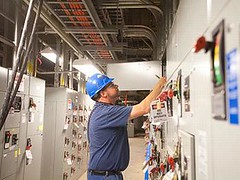燃煤電廠排放水銀、砷、鎳、硒、氰化物和酸性氣體 美國首度立法管制
 美國環保署21日首度發布對發電廠排放水銀(汞)、以及砷、鎳、硒、氰化物和酸性氣體等有毒空氣污染物的國家排放標準。人體接觸這些污染物,可能導致發育障礙以及呼吸系統疾病。
美國環保署21日首度發布對發電廠排放水銀(汞)、以及砷、鎳、硒、氰化物和酸性氣體等有毒空氣污染物的國家排放標準。人體接觸這些污染物,可能導致發育障礙以及呼吸系統疾病。
環保署長潔克森(Lisa Jackson)在一場記者會中表示,這項規範已經「醞釀了20年」,「對公眾、特別是孩童的健康而言,是重大的勝利。」潔克森說道,她現年15歲的兒子的第一個聖誕節是在醫院度過的,原因是呼吸方面的問題。她說,「包含我自己的數百萬個家庭將因此受惠。」
早在20年以前,美國國會就通過了《清淨空氣法》1990修正案,授權環保署對包括水銀等空氣污染源進行規範。為達成此要求,多年來環保署一直與工業界等利益相關者合作,盡量降低成本並提高靈活度以滿足最終的標準。
根據環保署的說法,新的保障措施每年將減少11000人夭折,4700個心臟病例。同時每年也將減少13萬名哮喘兒童以及6300例急性支氣管炎的病例。
潔克森說,「水銀暨有毒氣體排放標準(Mercury and Air Toxics Standards,MATS)能保護數百萬個家庭與兒童,免於有害且昂貴的空氣汙染,而且美國人因此得到的健康效益遠高過相對所花的成本。」
 然而,全美製造商協會總裁兼執行長帝蒙斯(Jay Timmons)表示,「環保署長潔克森完成的法案是最昂貴的環保法案之一,將會有損經濟成長與就業率。單單是2015年,公用事業執行最大可行控制技術(MACT)就會耗費114億美金。」他警告,「電力公司早就表明,如果實行這個規定,他們將被迫關閉全國各地的電廠,使電網的可靠性受到威脅。」
然而,全美製造商協會總裁兼執行長帝蒙斯(Jay Timmons)表示,「環保署長潔克森完成的法案是最昂貴的環保法案之一,將會有損經濟成長與就業率。單單是2015年,公用事業執行最大可行控制技術(MACT)就會耗費114億美金。」他警告,「電力公司早就表明,如果實行這個規定,他們將被迫關閉全國各地的電廠,使電網的可靠性受到威脅。」
但潔克森表示,「這個規範並沒有要求關閉電廠,而是進行排放管制。企業將做出決定,對現有工廠的排放改善進行投資、關閉老舊電廠或是建設新的電廠。我們的估計顯示,現有個電廠中只有0.5%會因此關閉,其中大部分都超過40至50年了。」
在今日,美國一半以上的燃煤電廠已經設有污染控制技術,這將有助於他們達成標準。潔克森說,「到最後,這個些標準將提升競爭環境水準,使現有40%的燃煤電廠採取類似的步驟,逐步減少排放有害的污染物。」
 美國總統歐巴馬所簽署的一份備忘錄寫道,「環保署與能源部的分析顯示,水銀暨有毒氣體排放標準(MATS)不會對國內既有的能源生產造成影響。清淨空氣法提供數項彈性措施,環保署過去有長久以來成功的經驗,可利用這些彈性以確保平順的轉換到更潔淨的技術。環保署的結論是4年應足以設置必要的排放控制設備,而能源局的結論也與之相當。」歐巴馬指出清淨空氣法「已提供環保署多一年的時間來達成目標,在特殊的情況之下有權限利用那樣的彈性。」
美國總統歐巴馬所簽署的一份備忘錄寫道,「環保署與能源部的分析顯示,水銀暨有毒氣體排放標準(MATS)不會對國內既有的能源生產造成影響。清淨空氣法提供數項彈性措施,環保署過去有長久以來成功的經驗,可利用這些彈性以確保平順的轉換到更潔淨的技術。環保署的結論是4年應足以設置必要的排放控制設備,而能源局的結論也與之相當。」歐巴馬指出清淨空氣法「已提供環保署多一年的時間來達成目標,在特殊的情況之下有權限利用那樣的彈性。」
針對上述說法,製造商協會所關注的仍是,新規則將使美國公司處境更加嚴峻。
 根據環保署估計,達成目標所需的污染控制設施相關設備之製造、工程、安裝與維護的工作,將提供數千個工作機會,潛在包含46000個短期工作以及8000個長期工作。但奧克拉荷馬州共和黨參議員殷霍夫(James Inhofe)並不買單,他指出,「可悲的是,這個法案與公共健康無關,」「這很明顯是一個所謂的電力稅,以延續歐巴馬政府在能源方面的戰爭,是一個前所未有的法規攻勢,來粉飾環保署這項使工作變少的調節議題。」
根據環保署估計,達成目標所需的污染控制設施相關設備之製造、工程、安裝與維護的工作,將提供數千個工作機會,潛在包含46000個短期工作以及8000個長期工作。但奧克拉荷馬州共和黨參議員殷霍夫(James Inhofe)並不買單,他指出,「可悲的是,這個法案與公共健康無關,」「這很明顯是一個所謂的電力稅,以延續歐巴馬政府在能源方面的戰爭,是一個前所未有的法規攻勢,來粉飾環保署這項使工作變少的調節議題。」
公共衛生和環保團體則是對新標準都拍手叫好。
 身為美國肺臟學會志願主席的醫師李佐(Albert Rizzo)表示,「由於發電廠產生的有毒空氣汙染物會讓人生病並減短壽命,新的水銀暨有毒氣體排放標準是公眾健康的一大勝利。」身兼德拉瓦州紐瓦克郡肺臟與重症照護醫生的李佐指出,「肺臟學會期望所有的燃煤與燃油電廠即刻採取行動,以保護全美國人,特別是孩童,免於這些危險空氣汙染物所造成的健康風險。」
身為美國肺臟學會志願主席的醫師李佐(Albert Rizzo)表示,「由於發電廠產生的有毒空氣汙染物會讓人生病並減短壽命,新的水銀暨有毒氣體排放標準是公眾健康的一大勝利。」身兼德拉瓦州紐瓦克郡肺臟與重症照護醫生的李佐指出,「肺臟學會期望所有的燃煤與燃油電廠即刻採取行動,以保護全美國人,特別是孩童,免於這些危險空氣汙染物所造成的健康風險。」
燃煤電廠是現在水銀、砷、氰化物以及其他危險汙染物的最大來源,其中水銀占了全美一半的排放量,而酸性氣體則佔了全美超過75%。
美國哮喘和過敏基金會總裁與執行長麥克林(Bill McLin)說,「我們知道某些批評者指出,更嚴格的標準對經濟造成不利的影響。然而,新的規定不僅避免了病患本身與哮喘兒家長在工資上的損失,也減少了雇用這些人的企業生產力下降,讓因此而住院的人數降低。」
伊利諾州潔淨能源協會成員雷坦(Bruce Ratain)表示,「歐巴馬總統已站起來對抗污染者並保護兒童的健康,這個里程碑反映出家長們的共識:提供電力的同時不應該傷害孩子。」
伊利諾州的電廠均已達成該州2006年通過的減排水銀標準,該標準與今現在聯邦所訂定的減少污染標準相當。
環保團體自然資源保護委員會(NRDC)主席拜內克(Frances Beinecke)說,「現在我們可以更自在的呼吸了!這個進展讓工業界主導而延宕了幾十年,如今環保署終於發揮了它原本的作用:看顧我們的健康與環境。」他表示,「骯髒的燃煤電廠將不得不清理所排放的污染,那些污染弄髒了空氣,並且使人們,尤其是孩子生病。潔淨空氣法的關鍵性修法,將能減少兒童發育遲緩、哮喘發作、心臟病以及癌症的發生,並拯救成千上萬的生命。」
拜內克認為,這項新規定是歐巴馬承諾保護美國人環境與健康的實踐,「除了減少水銀與其他有毒空氣汙染物外,歐巴馬也提議更高的二氧化碳排放與車輛燃油效率標準,相信不久的未來,就能看到電廠的二氧化碳排放也會受到管制。」
The U.S. Environmental Protection Agency today issued the first national standards that regulate power plant emissions of mercury and toxic air pollutants such as arsenic, nickel, selenium, cyanide and acid gases. Exposure to these emissions has been linked to developmental disorders and respiratory illnesses.
EPA Administrator Lisa Jackson told reporters on a conference call that the rule "has been 20 years in the making." The rule is "a great victory of public health, especially for the health of our children," declared Jackson, who said that her 15-year-old son spent his first Christmas in the hospital struggling to breathe. "Millions of families, including my own, will benefit."
More than 20 years ago, Congress passed the 1990 Clean Air Act Amendments, mandating that EPA require control of toxic air pollutants, including mercury. To meet this requirement, over the years EPA has worked with stakeholders, including industry, to minimize cost and maximize flexibilities in these final standards.
The new safeguards will prevent as many as 11,000 premature deaths and 4,700 heart attacks a year, according to the EPA. The standards will also prevent 130,000 cases of childhood asthma symptoms and about 6,300 cases of acute bronchitis among children each year.
"The Mercury and Air Toxics Standards will protect millions of families and children from harmful and costly air pollution and provide the American people with health benefits that far outweigh the costs of compliance," Jackson said.
National Association of Manufacturers President and CEO Jay Timmons said today, "EPA Administrator Lisa Jackson has finalized one of the most costly regulations that will do more damage to our economy and job growth. In 2015 alone, Utility MACT will cost $11.4 billion."
"Utility companies have made clear that they will be forced to shut down power generation plants throughout the country, and the reliability of the power grid will be threatened if this rule is implemented," warned Timmons.
But Jackson said today, "The rule does not require plant closures but control of emissions. Businesses will make decisions either to invest in controls for existing plants, close old plants or build new plants. Our estimates show that plants representing less than .5 percent of all generation will close, most of them plants over 40 or 50 years old."
Today, more than half of all coal-fired power plants in the United States already deploy pollution control technologies that will help them meet these achievable standards. "Once final, these standards will level the playing field by ensuring the remaining plants, about 40 percent of all coal fired power plants, take similar steps to decrease dangerous pollutants," said Jackson.
In the Memorandum, the President said, "Analyses conducted by the EPA and the Department of Energy (DOE) indicate that the MATS Rule is not anticipated to compromise electric generating resource adequacy in any region of the country. The Clean Air Act offers a number of implementation flexibilities, and the EPA has a long and successful history of using those flexibilities to ensure a smooth transition to cleaner technologies."
"The EPA has concluded that 4 years should generally be sufficient to install the necessary emission control equipment, and DOE has issued analysis consistent with that conclusion," Obama wrote, and pointed out that the Act "also provides the EPA with flexibility to bring sources into compliance over the course of an additional year, should unusual circumstances arise that warrant such flexibility."
Still, the manufacturers association is concerned that the new rule will make it tougher for American companies.
The agency estimates that manufacturing, engineering, installing and maintaining the pollution controls to meet these standards will provide employment for thousands of people, potentially including 46,000 short-term construction jobs and 8,000 long-term utility jobs.
"Sadly, this rule isn't about public health," Inhofe said. "It is a thinly veiled electricity tax that continues the Obama Administration's war on affordable energy and is the latest in an unprecedented barrage of regulations that make up EPA's job-killing regulatory agenda."
Public health and environmental groups applauded the new standards.
"Since toxic air pollution from power plants can make people sick and cut lives short, the new Mercury and Air Toxics Standards are a huge victory for public health," said Albert Rizzo, MD, national volunteer chair of the American Lung Association, and pulmonary and critical care physician in Newark, Delaware.
"The Lung Association expects all oil and coal-fired power plants to act now to protect all Americans, especially our children, from the health risks imposed by these dangerous air pollutants," Dr. Rizzo said.Coal-fired power plants are the largest remaining source of mercury, arsenic, cyanide, and other dangerous pollutants, and are responsible for half of the mercury and over 75 percent of the acid gas emissions in the United States.
Bill McLin, president and chief executive of the Asthma and Allergy Foundation of America, said, "We recognize that some critics cite adverse economic impacts of tighter standards. However, this new rule will not only avoid lost wages for patients and parents of children with asthma, lost productivity for the companies that employ them, and increased hospital admissions."
"Today President Obama stood up to polluters and protected children's health," said Bruce Ratain, clean energy associate with Environment Illinois. "This landmark achievement reflects what every parent knows: powering our homes should not poison our kids."
Illinois power plants have already achieved cuts in mercury pollution under a state mercury rule adopted in 2006, which requires pollution reductions similar to today's federal standard.
Frances Beinecke, president of the Natural Resources Defense Council, said, "We can breathe easier today. After decades of industry-induced delay, the Environmental Protection Agency did exactly what it was designed to do: look out for our health and our environment.
"Dirty coal-fired power plants will have to clean up the toxic soup of emissions that is polluting our air and making people sick, especially children. This critical update to the Clean Air Act will reduce child developmental delays, asthma attacks, heart attacks, and cancer; and save tens of thousands of lives.
Beinecke sees the new rule as a continuation of President Obama's initiatives to protect Americans' environment and health. "In addition to reducing mercury and other toxic air pollution," she said, "he proposed strong carbon dioxide pollution and fuel efficiency standards for cars and light trucks, and moved us closer toward curbing carbon dioxide pollution from power plants."







